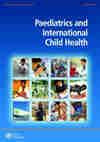Management of tuberculous meningitis in children.
IF 1.2
4区 医学
Q3 PEDIATRICS
Paediatrics and International Child Health
Pub Date : 2021-11-01
Epub Date: 2021-11-16
DOI:10.1080/20469047.2021.1952818
引用次数: 0
儿童结核性脑膜炎的处理。
本文章由计算机程序翻译,如有差异,请以英文原文为准。
求助全文
约1分钟内获得全文
求助全文
来源期刊

Paediatrics and International Child Health
PEDIATRICS-
CiteScore
3.30
自引率
0.00%
发文量
19
审稿时长
6-12 weeks
期刊介绍:
Paediatrics and International Child Health is an international forum for all aspects of paediatrics and child health in developing and low-income countries. The international, peer-reviewed papers cover a wide range of diseases in childhood and examine the social and cultural settings in which they occur. Although the main aim is to enable authors in developing and low-income countries to publish internationally, it also accepts relevant papers from industrialised countries. The journal is a key publication for all with an interest in paediatric health in low-resource settings.
 求助内容:
求助内容: 应助结果提醒方式:
应助结果提醒方式:


